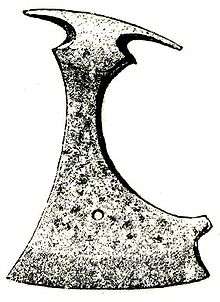Bearded axe
A bearded axe, or Skeggöx (from Old Norse Skegg, beard + öx, axe) refers to various axes, used as a tool and weapon, as early as the 6th century AD. It is most commonly associated with Viking Age Scandinavians. The lower portion of an axe bit is called the "beard" and the cutting edge of the bearded axe extends below the width of the butt to provide a wide cutting surface while keeping the overall weight of the axe low. The hook, or "beard" of the axe would also have been useful in battle, for example to pull weapons out of the defender's grasp, or to pull down a shield to allow another attacker to strike at the unprotected defender.
There are a number of variants in its design.[1]

Additionally this design allows the user to grip the haft directly behind the head for planing or shaving wood.
Variations of this design are still in use by modern woodworkers and some foresters.
See also
| Wikimedia Commons has media related to Long-bearded axe. |
References
- ↑ Jan Petersen, "De Norske Vikingesverd", Internet Archive Org Page 38, 1919
